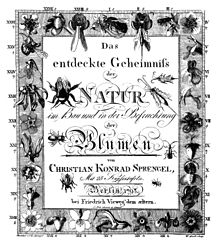
A pollinator is an animal that moves pollen from the male anther of a flower to the female stigma of a flower. This helps to bring about fertilization of the ovules in the flower by the male gametes from the pollen grains.

In biology, coevolution occurs when two or more species reciprocally affect each other's evolution through the process of natural selection. The term sometimes is used for two traits in the same species affecting each other's evolution, as well as gene-culture coevolution.
Between 1860 and 1868, the life and work of Charles Darwinfrom Orchids to Variation continued with research and experimentation on evolution, carrying out tedious work to provide evidence of the extent of natural variation enabling artificial selection. He was repeatedly held up by his illness, and continued to find relaxation and interest in the study of plants. His studies of insect pollination led to publication of his book Fertilisation of Orchids as his first detailed demonstration of the power of natural selection, explaining the complex ecological relationships and making testable predictions. As his health declined, he lay on his sickbed in a room filled with inventive experiments to trace the movements of climbing plants.

Zoophily, or zoogamy, is a form of pollination whereby pollen is transferred by animals, usually by invertebrates but in some cases vertebrates, particularly birds and bats, but also by other animals. Zoophilous species frequently have evolved mechanisms to make themselves more appealing to the particular type of pollinator, e.g. brightly colored or scented flowers, nectar, and appealing shapes and patterns. These plant-animal relationships are often mutually beneficial because of the food source provided in exchange for pollination.

The tribe Euglossini, in the subfamily Apinae, commonly known as orchid bees or euglossine bees, are the only group of corbiculate bees whose non-parasitic members do not all possess eusocial behavior.

Nectar is a sugar-rich liquid produced by plants in glands called nectaries or nectarines, either within the flowers with which it attracts pollinating animals, or by extrafloral nectaries, which provide a nutrient source to animal mutualists, which in turn provide herbivore protection. Common nectar-consuming pollinators include mosquitoes, hoverflies, wasps, bees, butterflies and moths, hummingbirds, honeyeaters and bats. Nectar plays a crucial role in the foraging economics and evolution of nectar-eating species; for example, nectar foraging behavior is largely responsible for the divergent evolution of the African honey bee, A. m. scutellata and the western honey bee.

Pollination syndromes are suites of flower traits that have evolved in response to natural selection imposed by different pollen vectors, which can be abiotic or biotic, such as birds, bees, flies, and so forth through a process called pollinator-mediated selection. These traits include flower shape, size, colour, odour, reward type and amount, nectar composition, timing of flowering, etc. For example, tubular red flowers with copious nectar often attract birds; foul smelling flowers attract carrion flies or beetles, etc.

Nectar robbing is a foraging behavior used by some organisms that feed on floral nectar, carried out by feeding from holes bitten in flowers, rather than by entering through the flowers' natural openings. "Nectar robbers" usually feed in this way, avoiding contact with the floral reproductive structures, and therefore do not facilitate plant reproduction via pollination. Because many species that act as pollinators also act as nectar robbers, nectar robbing is considered to be a form of exploitation of plant-pollinator mutualism. While there is variation in the dependency on nectar for robber species, most species rob facultatively.
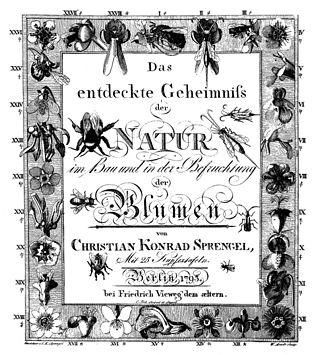
Christian Konrad Sprengel was a German naturalist, theologist, and teacher. He is most famous for his research on plant sexuality. Sprengel was the first to recognize that the function of flowers was to attract insects, and that nature favoured cross-pollination. Along with the work of Joseph Gottlieb Kölreuter he set the foundations for the modern study of floral biology and anthecology, but his work was not widely recognized until Charles Darwin examined and confirmed several of his observations almost 50 years later; see Fertilisation of Orchids (1862).

Angraecum sesquipedale, also known as Darwin's orchid, Christmas orchid, Star of Bethlehem orchid, and king of the angraecums, is an epiphytic orchid in the genus Angraecum endemic to Madagascar. The orchid was first discovered by the French botanist Louis-Marie Aubert du Petit-Thouars in 1798, but was not described until 1822. It is noteworthy for its long spur and its association with the naturalist Charles Darwin, who surmised that the flower was pollinated by a then undiscovered moth with a proboscis whose length was unprecedented at the time. Darwin's prediction went unverified for 21 years after his death, until just such a moth was discovered and his conjecture vindicated. The story of its postulated pollinator has come to be seen as one of the celebrated predictions of the theory of evolution.
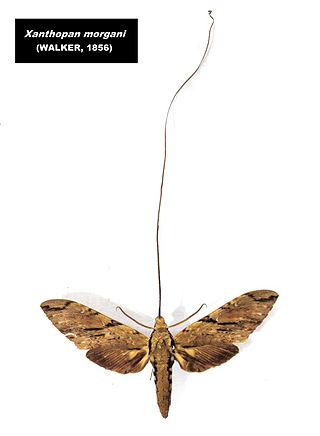
Xanthopan is a monotypic genus of sphinx moth, with Xanthopan morganii, commonly called Morgan's sphinx moth, as its sole species. It is a very large sphinx moth from Southern Africa and Madagascar. Little is known about its biology, though the adults have been found to visit orchids and are one of the main pollinators of several of the Madagascar endemic baobab (Adansonia) species, Adansonia perrieri or Perrier's baobab.
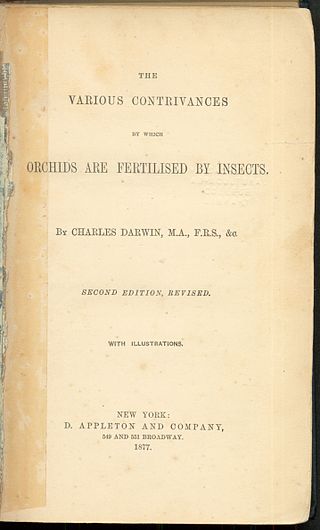
Fertilisation of Orchids is a book by English naturalist Charles Darwin published on 15 May 1862 under the full explanatory title On the Various Contrivances by Which British and Foreign Orchids Are Fertilised by Insects, and On the Good Effects of Intercrossing. Darwin's previous book, On the Origin of Species, had briefly mentioned evolutionary interactions between insects and the plants they fertilised, and this new idea was explored in detail. Field studies and practical scientific investigations that were initially a recreation for Darwin—a relief from the drudgery of writing—developed into enjoyable and challenging experiments. Aided in his work by his family, friends, and a wide circle of correspondents across Britain and worldwide, Darwin tapped into the contemporary vogue for growing exotic orchids.
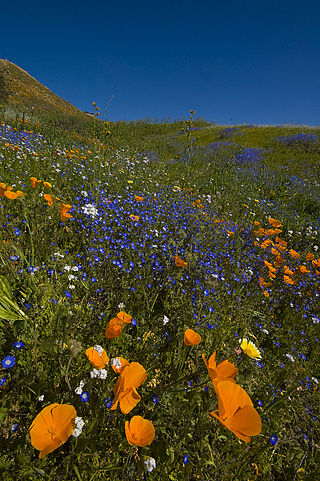
Frequency-dependent foraging is defined as the tendency of an individual to selectively forage on a certain species or morph based on its relative frequency within a population. Specifically for pollinators, this refers to the tendency to visit a particular floral morph or plant species based on its frequency within the local plant community, even if nectar rewards are equivalent amongst different morphs. Pollinators that forage in a frequency-dependent manner will exhibit flower constancy for a certain morph, but the preferred floral type will be dependent on its frequency. Additionally, frequency-dependent foraging differs from density-dependent foraging as the latter considers the absolute number of certain morphs per unit area as a factor influencing pollinator choice. Although density of a morph will be related to its frequency, common morphs are still preferred when overall plant densities are high.

In evolutionary biology, mimicry in plants is where a plant organism evolves to resemble another organism physically or chemically, increasing the mimic's Darwinian fitness. Mimicry in plants has been studied far less than mimicry in animals, with fewer documented cases and peer-reviewed studies. However, it may provide protection against herbivory, or may deceptively encourage mutualists, like pollinators, to provide a service without offering a reward in return.

Anthecology, or pollination biology, is the study of pollination as well as the relationships between flowers and their pollinators. Floral biology is a bigger field that includes these studies. Most flowering plants, or angiosperms, are pollinated by animals, and especially by insects. The major flower-frequenting insect taxa include beetles, flies, wasps, bees, ants, thrips, butterflies, and moths. Insects carry out pollination when visiting flowers to obtain nectar or pollen, to prey on other species, or when pseudo-copulating with insect-mimicking flowers such as orchids. Pollination-related interactions between plants and insects are considered mutualistic, and the relationships between plants and their pollinators have likely led to increased diversity of both angiosperms and the animals that pollinate them.
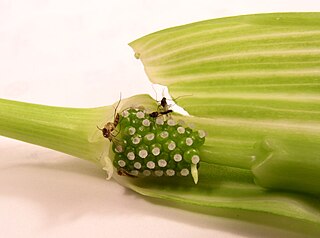
Pollination traps or trap-flowers are plant flower structures that aid the trapping of insects, mainly flies, so as to enhance their effectiveness in pollination. The structures of pollination traps can include deep tubular corollas with downward pointing hairs, slippery surfaces, adhesive liquid, attractants, flower closing and other mechanisms.
Floral biology is an area of ecological research that studies the evolutionary factors that have moulded the structures, behaviour and physiological aspects involved in the flowering of plants. The field is broad and interdisciplinary and involves research requiring expertise from multiple disciplines that can include botany, ethology, biochemistry, and entomology. A slightly narrower area of research within floral biology is sometimes called pollination biology or anthecology.

A nectar spur is a hollow extension of a part of a flower. The spur may arise from various parts of the flower: the sepals, petals, or hypanthium, and often contain tissues that secrete nectar (nectaries). Nectar spurs are present in many clades across the angiosperms, and are often cited as an example of convergent evolution.

Pollinator-mediated selection is an evolutionary process occurring in flowering plants, in which the foraging behavior of pollinators differentially selects for certain floral traits. Flowering plant are a diverse group of plants that produce seeds. Their seeds differ from those of gymnosperms in that they are enclosed within a fruit. These plants display a wide range of diversity when it comes to the phenotypic characteristics of their flowers, which attracts a variety of pollinators that participate in biotic interactions with the plant. Since many plants rely on pollen vectors, their interactions with them influence floral traits and also favor efficiency since many vectors are searching for floral rewards like pollen and nectar. Examples of pollinator-mediated selected traits could be those involving the size, shape, color and odor of flowers, corolla tube length and width, size of inflorescence, floral rewards and amount, nectar guides, and phenology. Since these types of traits are likely to be involved in attracting pollinators, they may very well be the result of selection by the pollinators themselves.

The pollination of orchids is a complex chapter in the biology of this family of plants that are distinguished by the complexity of their flowers and by intricate ecological interactions with their pollinator agents. It has captured the attention of numerous scientists over time, including Charles Darwin, father of the theory of evolution by natural selection. Darwin published in 1862 the first observations of the fundamental role of insects in orchid pollination, in his book The Fertilization of Orchids. Darwin stated that the varied stratagems orchids use to attract their pollinators transcend the imagination of any human being.
